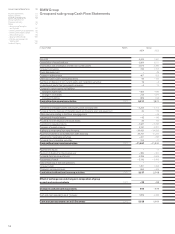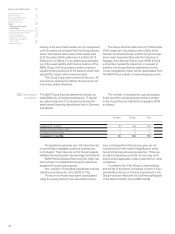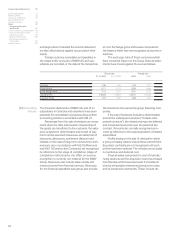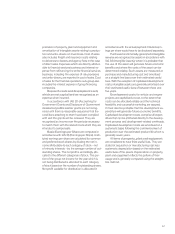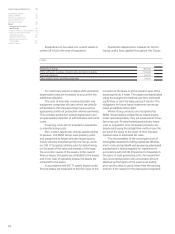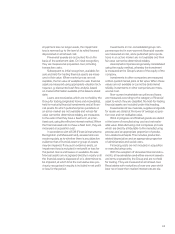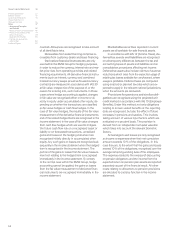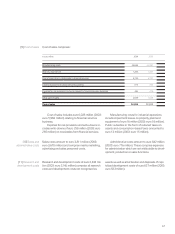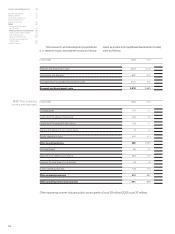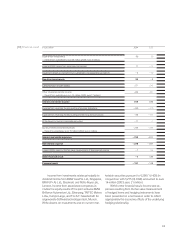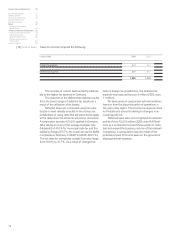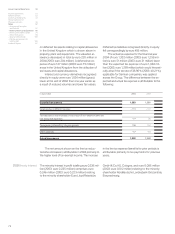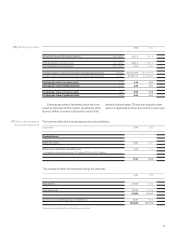BMW 2004 Annual Report Download - page 65
Download and view the complete annual report
Please find page 65 of the 2004 BMW annual report below. You can navigate through the pages in the report by either clicking on the pages listed below, or by using the keyword search tool below to find specific information within the annual report.64
Group Financial Statements 50
Income Statements 51
Balance Sheets 52
Cash Flow Statements 54
Group Statement of
Changes in Equity 56
Notes 57
--Accounting Principles
and Policies 57
--Notes to the Income Statement 66
--Notes to the balance sheet 74
--Other Disclosures 93
--Segment Information 100
--Disclosures pursuant to
§292a HGB
104
Auditors’ Report 107
counted. Allowances are recognised to take account
of all identifiable risks.
Receivables from sales financing comprise re-
ceivables from customer, dealer and lease financing.
Derivative financial instruments are only
used within the BMW Group for hedging purposes,
in order to reduce the currency, interest rate and mar-
ket price risks from operating activities and related
financing requirements. All derivative financial instru-
ments (such as interest, currency and combined
interest/currency swaps as well as forward currency
contracts) are measured in accordance with IAS 39
at fair value, irrespective of the purpose of, or the
reason for entering into, such instruments. In those
cases where hedge accounting is applied, changes
in fair value are recognised either in income or di-
rectly in equity under accumulated other equity, de-
pending on whether the transactions are classified
as fair value hedges or cash flow hedges. In the
case of fair value hedges, the results of the fair value
measurement of the derivative financial instruments
and of the related hedged items are recognised in the
income statement. In the case of fair value changes
from cash flow hedges which are used to mitigate
the future cash flow risk on a recognised asset or
liability or on forecasted transactions, unrealised
gains and losses on the hedging instrument are
recognised initially directly in accumulated other
equity. Any such gains or losses are recognised sub-
sequently in the income statement when the hedged
item is recognised in the income statement.The
portion of the gains or losses from fair value measure-
ment
not relating to the hedged item is recognised
immediately in the income statement. If, contrary
to the normal case within the BMW Group, hedge
accounting cannot be applied, the gains or losses
from the fair value measurement of derivative finan-
cial instruments are recognised immediately in the
income statement.
Marketable securities reported in current
assets are all available-for-sale financial assets.
In accordance with IAS 12 (Income Taxes), de-
ferred tax assets and liabilities are recognised
on all temporary differences between the tax and
accounting bases of assets and liabilities and on
consolidation procedures affecting net income.
Deferred tax assets also include claims to future tax
reductions which arise from the expected usage of
existing tax losses available for carryforward, where
usage is probable. Deferred taxes are computed
using enacted or planned tax rates which are ex-
pected to apply in the relevant national jurisdictions
when the amounts are recovered.
Provisions for pensions and similar obli-
gations are recognised using the projected unit
credit method in accordance with IAS 19 (Employee
Benefits). Under this method, not only obligations
relating to known vested benefits at the reporting
date are recognised, but also the effect of future
increases in pensions and salaries. This involves
taking account of various input factors which are
evaluated on a prudent basis. The provision is
derived from an independent actuarial valuation
which takes into account the relevant biometric
factors.
Actuarial gains and losses are only recognised
as income or expenses when their net cumulative
amount exceeds 10% of the obligations. In this
case they are, to the extent that the gains and losses
exceed 10% of the obligations, recognised over the
average remaining working lives of the employees.
The expense related to the reversal of discounting
on pension obligations and the income from the
expected return on pension plan assets are reported
separately as part of the financial result. All other
costs relating to allocations to pension provisions
are allocated to costs by function in the income
statement.


